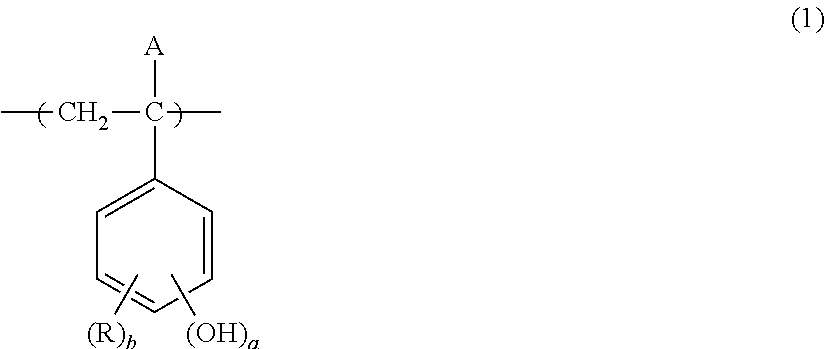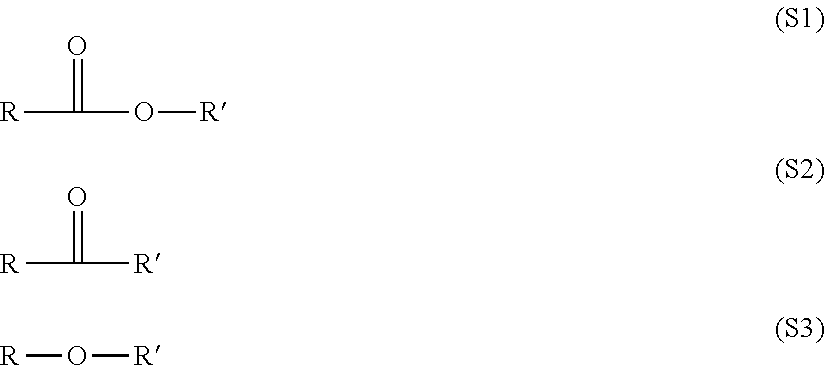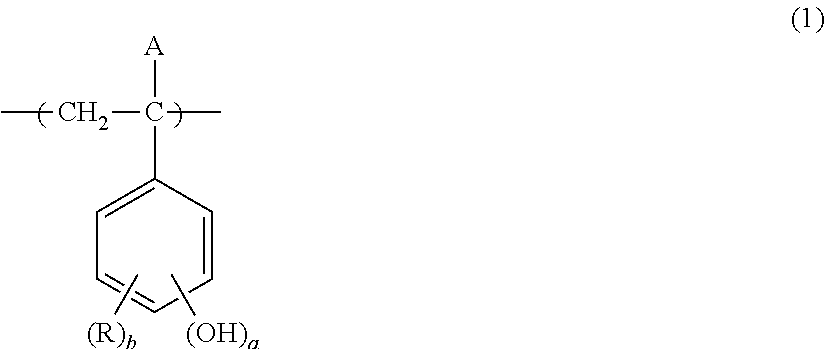Negative resist pattern forming method, developer and negative chemical-amplification resist composition used therefor, and resist pattern
a technology of chemical amplification and pattern forming, applied in the direction of photosensitive materials, instruments, photomechanical apparatuses, etc., can solve the problems of deterioration of electrical properties, reduction of yield, and inability to meet high sensitivity, high resolution, and good pattern profile and line width roughness in the ultrafine region at the same time, so as to achieve high sensitivity and high resolution , the effect of enhancing performan
- Summary
- Abstract
- Description
- Claims
- Application Information
AI Technical Summary
Benefits of technology
Problems solved by technology
Method used
Image
Examples
synthesis example 1
Synthesis of Resin (29)
[0302]3.9 Gram (0.024 mol) of 4-acetoxystyrene and 0.8 g (0.006 mol) of 4-methoxystyrene were dissolved in 30 ml of 1-methoxy-2-propanol and thereto, 70 ml of a 1-methoxy-2-propanol solution containing 50 mg of 2,2′-azobis(2,4-dimethylvaleronitrile) (V-65, trade name, produced by Wako Pure Chemical Industries, Ltd.) as a polymerization initiator, 9.1 g (0.056 mol) of 4-acetoxystyrene and 1.9 g (0.014 mol) of 4-methoxystyrene was added dropwise at 70° C. over 2 hours under stirring in a nitrogen stream. After 2 hours, 50 mg of the initiator was added, and the reaction was further allowed to proceed for 2 hours. Thereafter, the temperature was raised to 90° C., and the stirring was continued for 1 hour. The obtained reaction solution was allowed to cool and then poured in 1 L of ion-exchanged water with vigorous stirring to precipitate a white resin. The resin obtained was dried and then dissolved in 100 ml of methanol and after adding an aqueous 25 mass % tetra...
examples 1 to 21
(1) Preparation and Coating of Negative Resist Coating Solution
[0307]A coating solution composition having the formulation shown in Table 1 was microfiltered through a membrane filter having a pore size of 0.1 μm to obtain a resist solution. In Table 1, the ratio when using two or more kinds of components is the ratio by mass.
[0308]This resist solution was applied on an HMDS-treated 6-inch Si wafer by using a spin coater, Mark 8, manufactured by Tokyo Electron Ltd. and dried on a hot plate at 110° C. for 90 seconds to obtain a 0.2 μm-thick resist film.
(2) Evaluation of EB Exposure
[0309]The resist film obtained in (1) above was subjected to pattern irradiation using an electron beam lithography system (HL750 manufactured by Hitachi, Ltd., accelerating voltage: 50 KeV). After the irradiation, the resist film was heated on a hot plate at 120° C. for 90 seconds.
[0310]Subsequently, the resist film was spray-developed using the organic solvent shown in Table 1 at a flow rate of 200 mL / min...
examples 22 to 42
(3) Preparation and Coating of Negative Resist Coating Solution
[0334]The coating solution composition shown in Table 3 was microfiltered through a membrane filter having a pore size of 0.1 μm to obtain a resist solution.
[0335]This resist solution was applied on an HMDS-treated 6-inch Si wafer by using a spin coater, Mark 8, manufactured by Tokyo Electron Ltd. and dried on a hot plate at 110° C. for 90 seconds to obtain a 0.1 μm-thick resist film.
(4) Evaluation of EUV Exposure
[0336]The resist film obtained was subjected to surface exposure using EUV light (wavelength: 13 nm) by changing the exposure dose in steps of 0.5 mJ / cm2 in the range from 0 to 10.0 mJ / cm2.
[0337]After the irradiation, the resist film was heated on a hot plate at 120° C. for 90 seconds.
[0338]Subsequently, the resist film was spray-developed using the organic solvent shown in Table 3 at a flow rate of 200 mL / min for 30 seconds and then dried by high-speed spinning of 2,000 revolutions (rpm) for 20 seconds.
[0339]In...
PUM
| Property | Measurement | Unit |
|---|---|---|
| Percent by mass | aaaaa | aaaaa |
| Percent by mass | aaaaa | aaaaa |
| Mass | aaaaa | aaaaa |
Abstract
Description
Claims
Application Information
 Login to View More
Login to View More - R&D
- Intellectual Property
- Life Sciences
- Materials
- Tech Scout
- Unparalleled Data Quality
- Higher Quality Content
- 60% Fewer Hallucinations
Browse by: Latest US Patents, China's latest patents, Technical Efficacy Thesaurus, Application Domain, Technology Topic, Popular Technical Reports.
© 2025 PatSnap. All rights reserved.Legal|Privacy policy|Modern Slavery Act Transparency Statement|Sitemap|About US| Contact US: help@patsnap.com



